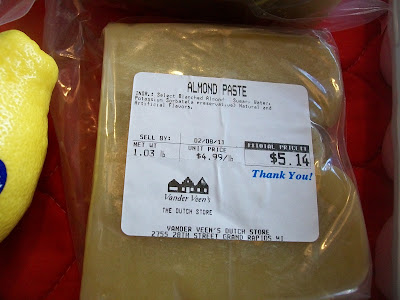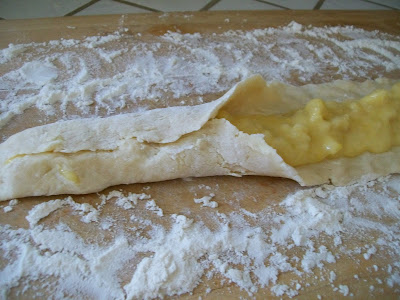When my son, Matthew, and my Grandson, Bradley, tasted this Banket, they both said the same thing. "Oh this is good! This is so good!!!" The Banket is mainly almond filling with just a thin flaky, crunchy crust. This proves homemade is BEST!!
I spent a delightful time last week with my lovely neighbor, Joyce, making her Mother's Dutch Banket from a recipe that originally came from a 1934 Dutch Cookbook.
Banket is a Dutch pastry eaten during the Christmas season specially for St. Nicholas Day. When I was young, we enjoyed it all year round. It is sometimes called Almond Roll or Dutch Letters. It consists of pastry wrapped around an almond paste filling. The finished pastry can be shaped in a log shape or into a letter, like an S for Sinterklaas. Made at home, the Banket is offend shaped into initials representing the first letter of each person in the family's name. In the Netherlands, the custom of giving a person a Banket, bread or chocolate initial goes back to the 16th Century
My Mom and her Mom did not make Banket. They purchased it from Buttercup Bakery. Bonket was very important part of my childhood. My Dad, Mom, and I would have Banket and homemade cookies for tea in the afternoon when my Dad was at home. It was such a special time.
Bant made in bakeries uses a puff pastry for the pastry part of the Banket so it keeps its round log shape.
My Dad's Mom came from the Netherlands in 1912. By the time I came along, she lived in Arizona so I didn't see her very often. My Cousin who lived with her said Grandma B. made Almond Roll. However, stab me in the heart, my cousin gave Grandma's cookbooks to a friend of hers. Hurt, hurt, hurt!!!
My neighbor, Joyce, was born in the Netherlands and came with her family to the United States after World War II. When her Mom was young, she went to a Housekeeping School as that was considered necessary to get a husband. Her Mom received this book at the school.
Joyce and I used a recipe card on which the recipe was translated into English. The only difference in the recipe from the book and the recipe card, the recipe in the book included not only lemon juice but some lemon rind. Joyce and I added the lemon rind to our Banket.
Banket is very important part of St. Nicholas Day on December 6th. Joyce has a wonderful collection of St. Nicholas figures. St. Nicholas became Sinterklaas (Santa Claus) in the Netherlands.
TO MAKE THE FILLING FOR BANKET
When buying almond paste be sure the first ingredient on the label is almonds not sugar. There is a canned product called almond filling but that will not work right for Banket. Marzipan is made with almond paste, but also will not work in the Banket filling.
JOYCE'S BANKET FILLING
1 to 1 1/2 lb. almond paste, Joyce uses 2lb.
4 eggs, 1 separated
2 c sugar
1 T lemon juice
Grated lemon rind from about a half of a lemon
Ingredients: Almond paste, sugar, eggs, and lemon.
Put almond paste in a mixing bowl and crumble with your fingers or with a fork. To crumbled paste, add three eggs and one egg yolk. Reserve the egg white for brushing on the Banket to make a glaze before baking. Mix paste and eggs well. Add sugar and mix well. Add lemon juice, and lemon rind. Mix well and chill for one hour. (Joyce and I didn't chill the filling.)
In a mixing bowl,
Crumble almond paste with fingers.
Almond paste crumbled.
Add three eggs and one egg yolk. Reserve the egg white for a glaze.
Add sugar.
Mix well with a fork.
Add lemon rind.
Mix.
Add lemon juice and mix well. A few lumps do not matter. They will melt in the oven.
TO MAKE THE BANKET PASTRY
BANKET PASTRY
4 c flour
1 lb. butter
1/2 t salt
1 c ice water
Ingredients: Flour, butter, salt, and ice water.
For the pastry: On the recipe card the directions say, mix and separate into 8 balls. Joyce and I cut the butter into pats. With your fingers or pastry blender work the butter into flour. Add the ice water and work the butter, flour, and ice water together with your fingers until all the flour is moist. Joyce suggests forming the dough into 8-1/2 balls so you have some dough from the half ball to repair any rips in the dough of the Banket after it is transferred to baking sheet. Put flour on a board. Put ball of dough on the flour and flatten the ball into an oblong shape. With fingers and side of your hand, push dough into about an 18-inch long by 3-inch wide strip of dough. (Directions say to roll the filling into a large worm.) Joyce spoons filling down the center of the strip of dough. Pick up one side of the dough at a time and fold it over the filling. Repeat with second side of dough. Pinch and press the two sides of dough together over filling. Brush log of dough with reserved egg white, beaten. Sprinkle sugar on to brushed egg white. With sharp knife, cut slits about every 2 1/2-inches down the top of the log. Using a spatula, loosen the log from the board and carefully transfer to a baking sheet well greased with butter. Bake in a preheated 400 degree F. oven for 25 minutes. Remove logs from baking sheet and wrap in waxed paper and then in aluminium foil to store. Freezes well.

Remove wrappers from butter and cut into pats.
Put flour in a mixing bowl and add salt. Mix well.
Add butter. With fingers work the butter into the flour and add ice water. Mix all the ingredients together until all the flour is moistened.
Grease baking sheet well with butter.
Beat reserved egg white. Form dough into 8 or 8 1/2 balls so you have some dough to patch any rips in the dough.
As Joyce says, "Molest those little balls until all the ingredients are one."
Flour a board and place a ball of dough on it. With hand flatten the ball into an oblong shape.
With your fingers and side of your hand push the dough into an approximately 18 x 3-inch strip of dough.
Put one-eight of filling down the center of the dough with a spoon.
Carefully fold the edges of dough over the filling. Pinch and pat the edges together. Pinch any openings in the dough together.
Brush Banket log with beaten egg white.
Sprinkle with sugar.
With a sharp knife, cut slits in the dough about 3 inches apart.
Carefully lift the log to a well buttered baking pan.
Bake in preheated 400 degree F. oven for 25 minutes.
Start over with second ball of dough.
Press ball into an oblong on floured board. Continue as for 1st Banket.
Baked Banket.
Wrap each log in waxed paper and then aluminum foil for storage. Banket freezes well.
Baked Banket.
 Wrapped in waxed paper before aluminum foil.
Wrapped in waxed paper before aluminum foil.
 Ready to serve.
Ready to serve.
Slice.
ENJOY
ENJOY
ENJOY!!!
EET SMAKELIJK!!
I will eat all the ends if you want.
PS: If you have left over filling, use a tube of refrigerated crescent dough and put filling into the triangle of dough before rolling the dough into a crescent. Bake as directed on the crescent roll package.
























































